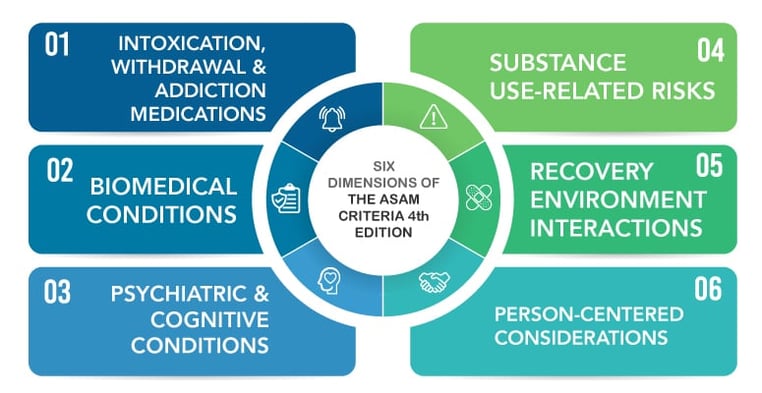What are the Six Dimensions in The ASAM Criteria 4th Edition?

The ASAM Criteria are the most widely used guidelines for assessment, service planning and placement for individuals with addiction and co-occurring conditions. In ASAM’s multidimensional assessment, the six dimensions are used to summarize a person’s needs, define severity and develop a treatment plan. Clinicians use the dimensions to identify problems, goals and treatment plan objectives. The dimensions were updated in The ASAM Criteria 4th Edition.
The six dimensions of The ASAM Criteria 4th Edition are:
-
Intoxication, Withdrawal and Addiction Medications
-
Biomedical Conditions
-
Psychiatric and Cognitive Conditions
-
Substance Use-Related Risks
-
Recovery Environment Interactions
-
Person-Centered Considerations

The Six Dimensions of The ASAM Criteria 4th Edition:
- Intoxication, Withdrawal and Addiction Medicine
The first dimension assesses a person’s immediate risk related to acute intoxication and anticipated withdrawal. Clinicians can evaluate the severity of signs and symptoms to determine the appropriate level of medical management. This can include evaluating the need for Medications for Opioid Use Disorder (MOUD) to prevent opioid withdrawal.
- Biomedical Conditions
The second dimension considers the individual’s need for physical health services. It also explores the relationship between substance use and co-occurring physical health challenges. The goal is to determine whether the person needs additional physical health services. Medically managed care can include acute stabilization, prenatal care and ongoing management of a chronic condition.
- Psychiatric and Cognitive Conditions
The third dimension evaluates the need to address co-occurring mental health challenges. This may include cognitive, behavioral, psychiatric and trauma-related conditions. Clinicians also consider the relationship between substance use and any co-occurring mental health problems. The goal is to determine whether signs and symptoms can be addressed safely through addiction treatment (i.e., mood swings due to drug use) or warrant additional mental health services (i.e., mood swings due to concurrent bipolar disorder).
- Substance Use-Related Risks
The fourth dimension assesses the likelihood that an individual will engage in risky substance use and related behaviors. It considers: the person’s recent and historical patterns of use, the potential for dangerous consequences (i.e., overdose, injury, driving while impaired, risky sexual behavior or criminal behavior), the likely imminency of these consequences, exposure to triggers in the person’s daily environment, awareness of triggers, access to substances and ability to cope with stressors and cravings.
- Recovery Environment Interactions
The fifth explores an individual’s ability to function, safety and support in their current environment. If a person is not currently functioning effectively, they may benefit from developing their social skills or independent living skills. A person’s needs in this dimension also could include housing, financial, vocational, educational, legal, transportation or child care services. Clinicians can also examine whether family members, significant others or school, work and living situations pose a threat to the person’s treatment and recovery.
- Person-Centered Considerations
The sixth dimension is completed after the other five dimensions are assessed. In this dimension, we consider a person’s obstacles to care, treatment preferences and need to enhance motivation. The goal is for the clinician and patient to practice shared decision-making to determine the appropriate level of care, respecting the person’s autonomy, culture, social determinants of health, trauma, etc.
Learn how we're getting ready for the release of The ASAM Criteria 4th Edition and how we can support you in implementation.

